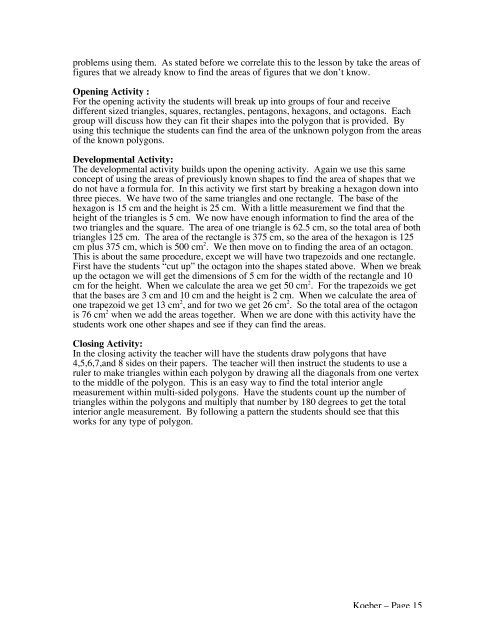Mary Koerber Geometry in two dimensional and three dimensional ...
Mary Koerber Geometry in two dimensional and three dimensional ...
Mary Koerber Geometry in two dimensional and three dimensional ...
- No tags were found...
Create successful ePaper yourself
Turn your PDF publications into a flip-book with our unique Google optimized e-Paper software.
problems us<strong>in</strong>g them. As stated before we correlate this to the lesson by take the areas offigures that we already know to f<strong>in</strong>d the areas of figures that we don’t know.Open<strong>in</strong>g Activity :For the open<strong>in</strong>g activity the students will break up <strong>in</strong>to groups of four <strong>and</strong> receivedifferent sized triangles, squares, rectangles, pentagons, hexagons, <strong>and</strong> octagons. Eachgroup will discuss how they can fit their shapes <strong>in</strong>to the polygon that is provided. Byus<strong>in</strong>g this technique the students can f<strong>in</strong>d the area of the unknown polygon from the areasof the known polygons.Developmental Activity:The developmental activity builds upon the open<strong>in</strong>g activity. Aga<strong>in</strong> we use this sameconcept of us<strong>in</strong>g the areas of previously known shapes to f<strong>in</strong>d the area of shapes that wedo not have a formula for. In this activity we first start by break<strong>in</strong>g a hexagon down <strong>in</strong>to<strong>three</strong> pieces. We have <strong>two</strong> of the same triangles <strong>and</strong> one rectangle. The base of thehexagon is 15 cm <strong>and</strong> the height is 25 cm. With a little measurement we f<strong>in</strong>d that theheight of the triangles is 5 cm. We now have enough <strong>in</strong>formation to f<strong>in</strong>d the area of the<strong>two</strong> triangles <strong>and</strong> the square. The area of one triangle is 62.5 cm, so the total area of bothtriangles 125 cm. The area of the rectangle is 375 cm, so the area of the hexagon is 125cm plus 375 cm, which is 500 cm 2 . We then move on to f<strong>in</strong>d<strong>in</strong>g the area of an octagon.This is about the same procedure, except we will have <strong>two</strong> trapezoids <strong>and</strong> one rectangle.First have the students “cut up” the octagon <strong>in</strong>to the shapes stated above. When we breakup the octagon we will get the dimensions of 5 cm for the width of the rectangle <strong>and</strong> 10cm for the height. When we calculate the area we get 50 cm 2 . For the trapezoids we getthat the bases are 3 cm <strong>and</strong> 10 cm <strong>and</strong> the height is 2 cm. When we calculate the area ofone trapezoid we get 13 cm 2 , <strong>and</strong> for <strong>two</strong> we get 26 cm 2 . So the total area of the octagonis 76 cm 2 when we add the areas together. When we are done with this activity have thestudents work one other shapes <strong>and</strong> see if they can f<strong>in</strong>d the areas.Clos<strong>in</strong>g Activity:In the clos<strong>in</strong>g activity the teacher will have the students draw polygons that have4,5,6,7,<strong>and</strong> 8 sides on their papers. The teacher will then <strong>in</strong>struct the students to use aruler to make triangles with<strong>in</strong> each polygon by draw<strong>in</strong>g all the diagonals from one vertexto the middle of the polygon. This is an easy way to f<strong>in</strong>d the total <strong>in</strong>terior anglemeasurement with<strong>in</strong> multi-sided polygons. Have the students count up the number oftriangles with<strong>in</strong> the polygons <strong>and</strong> multiply that number by 180 degrees to get the total<strong>in</strong>terior angle measurement. By follow<strong>in</strong>g a pattern the students should see that thisworks for any type of polygon.Koeber – Page 15
















